#ancient yoga philosophy
Explore tagged Tumblr posts
Text
Post 2: The First Steps of Yoga: Stillness and Strength in Practice
“Now, the discipline of yoga begins.”—Patanjali, Yoga Sutra 1.1 With this simple declaration, Patanjali invites us into the present moment. “Atha Yoganushasanam” is a call to awaken to the path of yoga, the path of inner discipline and self-realization. It is a call to begin, no matter where we are in our lives. Yoga, in its deepest sense, is the discipline of mind, body, and spirit—and it…
#ancient yoga philosophy#calming the mind#cessation of mind fluctuations#cultivating stillness#discipline of yoga#inner peace through yoga#inner strength#Meditation practice#mental clarity#mind-body balance#Patanjali Sutra 1.1#Patanjali Sutra 1.2#Patanjali’s teachings#presence in yoga#Raja Yoga#Self-awareness#spiritual discipline#spiritual growth#Swami Vivekananda translation#the path of stillness#Vrittis#yoga for beginners#yoga for mental peace#Yoga Sutras of Patanjali#yogic philosophy#yogic wisdom
0 notes
Text
#Bhagavad Gita#life guide#spiritual wisdom#timeless teachings#personal growth#ancient philosophy#inner peace#dharma#karma#Vedic knowledge#enlightenment#purposeful living#mindfulness guide#soulful journey#self-realization#yoga philosophy#meditation practice#spiritual awakening#ancient scriptures#life purpose guide
0 notes
Text
Unlock the Secrets of Ancient Wisdom in Modern Times
In an era dominated by rapid technological advancements and a fast-paced lifestyle, the timeless teachings of ancient wisdom can offer us a sense of balance, peace, and profound understanding. These age-old principles, rooted in various cultures and traditions, provide a roadmap for living harmoniously with ourselves and the world around us. In this article, we will explore the essence of ancient…

View On WordPress
#Ancient Wisdom#Ayurveda#Chinese Medicine#Environmental Stewardship#Ethical Living#Greek Philosophy#Holistic Health#Indigenous Wisdom#meditation#Mindful Living#mindfulness#Modern Times#Nature Connection#personal growth#self-care#Social Harmony#Spiritual Fulfillment#Sustainable Living#well-being#Yoga
0 notes
Text
To My Dear Brothers & Sisters in Jesus Christ....
Yoga & Meditation
This topic came to my attention recently once again. Christians prompting meditation and yoga within the church. Personally coming from a paradox background of being raised in the church and then straying into dark waters into different practices, I can honestly say this should not be encouraged in the Body of Christ. I even know of “yoga ministries” or “christian yoga” sprouting up in christian circles. This cannot and shouldn’t be a thing among us.
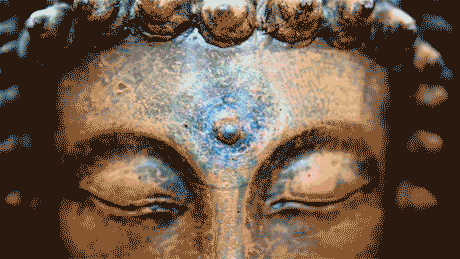
The practice of yoga is originated from India and rooted in both Hinduism, and Buddhism. To boil it all down to the basic beliefs of yoga and meditation is the awakening and discipline of the mind and body. The word “namaste” is spoke aloud at the end of every yoga session. It’s means “welcome”, referring to the reawakening and re-consciousness of one self. I know this because I’ve tried yoga in the past and learned what “namaste” meant. All other knowledge of these religious practices comes from further personal research and prayer. So at its core, meditation and yoga is to aid one to achieve control over themselves based solely on their own will. This “spiritual” philosophy totally goes against the Christian faith.
We as Christians, have chosen to give up the illusion of control to God because we were never in control of our own lives or anyone else’s in the first place. Only God our Creator is in control. Believing we can live this life on earth without Jesus, without God, leads to a meaningless and empty end. “Everything is meaningless,” says the Teacher, “completely meaningless!” What do people get for all their hard work under the sun?” (Ecclesiastes 1:2-3 NLT)
A reminder, this post is only addressed to my fellow believers in Jesus Christ. Those who’ve accepted Him as their Savior and Redeemer because we’ve accepted the truth of our sinful natures. It is through Christ that we are healed and whole. With all that said, we must be alert and sober to what practices we allow or invite into the Body of Christ. Modern variations of ancient religious practices do not cancel out their true intent. Like for example, renaming the yoga practice; “christian yoga”, and its many poses to better fit this current time or modern ideals. There’s been already so much compromise to our faith throughout the centuries as it is. We must take ownership and responsibility so no other believer may stumble in their walk with Jesus. Modern New Age thinking meditation and yoga has already penetrated our church walls, chose to be a vigilante watchmen on the wall. (Isaiah 62:6-9) In Jesus Name!
#yoga#christians#christian yoga#meditation#hinduism#buddhism#ancient practices#ancient history#christianity#new age#new age practices#modern day#modern philosophy#walking with god#walking with Jesus#the body of christ#the church#church#compromise#responsibility#ownership#watchmen on the wall#watchmen#being a Christian#being human#mistakes#struggle#look to Jesus#pray#red flag symbols for christians
1 note
·
View note
Text
South Asian and Hindu Influences in ATLA (Part 2)
disclaimer: i was raised culturally and religiously hindu, and though i've tried to do my research for this post and pair it with my own cultural knowledge, i'm not an expert on hinduism by any means. should i mess up, please let me know.
please also be aware that many of the concepts discussed in this post overlap heavily with religions such as buddhism and jainism, which might have different interpretations and representations. as i'm not from those religions or cultures, i don't want to speak on them, but if anyone with that knowledge wishes to add on, please feel free.
Part 1
In the previous post, I discussed some of the things ATLA got right in its depictions of desi and hindu cultures. unfortunately, they also got plenty of things wrong - often in ways that leaned towards racist caricatures - so let's break them down, starting with...
Guru Pathik
both the word "guru" and name "pathik" come from sanskrit. pathik means "traveler" or "he who knows the way" while guru is a term for a guide or mentor, similar to a teacher.
gurus were responsible for the very first education systems in ancient india, setting up institutions called gurukuls. students, referred to as disciples, would often spend years living with and learning from their gurus in these gurukuls, studying vedic and buddhist texts, philosophy, music and even martial arts.
however, their learning was not limited merely to academic study, as gurus were also responsible for guiding the spiritual evolution of their disciples. it was common for disciples to meditate, practice yoga, fast for days or weeks, and complete mundane household chores every day in order to instill them with self-discipline and help them achieve enlightenment and spiritual awareness. the relationship between a guru and his disciple was considered a sacred, holy bond, far exceeding that of a mere teacher and student.
aang's training with guru pathik mirrors some of these elements. similar to real gurus, pathik takes on the role of aang's spiritual mentor. he guides aang in unblocking his chakras and mastering the avatar state through meditation, fasting, and self-reflection - all of which are practices that would have likely been encouraged in disciples by their gurus.
pathik's design also takes inspiration from sadhus, holy men who renounced their worldly ties to follow a path of spiritual discipline. the guru's simple, nondescript clothing and hair are reflective of the ascetic lifestyle sadhus are expected to lead, giving up material belongings and desires in order to achieve spiritual enlightenment and, ultimately, liberation from the reincarnation cycle.
unfortunately, this is where the respectful references end because everything else about guru pathik was insensitive at best and stereotypical at worst.
it is extremely distasteful that the guru speaks with an overexaggerated indian accent, even though the iranian-indian actor who plays him has a naturally british accent. why not just hire an actual indian voice actor if the intention was to make pathik sound authentic? besides, i doubt authenticity was the sole intention, given that the purposeful distortion of indian accents was a common racist trope played for comedy in early 2000s children's media (see: phineas and ferb, diary of a wimpy kid, jessie... the list goes on).
furthermore, while pathik is presented a wise and respected figure within this episode, his next (and last) appearance in the show is entirely the opposite.

in the episode nightmares and daydreams, pathik appears in aang's nightmare with six hands, holding what appears to be a veena (a classical indian music instrument). this references the iconography of the hindu deity Saraswati, the goddess of wisdom and knowledge. the embodiment of divine enlightenment, learning, insight and truth, Saraswati is a member of the Tridevi (the female version of the Trimurti), one of the most respected and revered goddesses in the Hindu pantheon... and her likeness is used for a cheap laugh on a character who's already treated as a caricature.
that's bad enough on its own, but when you consider that guru pathik is the only explicitly south asian coded character in the entire show, it's downright insulting. for a show that took so many of its foundational concepts from south asia and hinduism and yet provided almost no desi representation in return, this is just rubbing salt in the wound.
Chakras
"chakra", meaning "circle" or "wheel of life" in sanskrit, refers to sources of energy found in the human body. chakra points are aligned along the spine, with energy flowing from the lowest to the highest point. the energy pooled at the lowest chakra is called kundalini, and the aim is to release this energy to the highest chakra in order to achieve spiritual enlightenment and consciousness.
the number of chakras varies in different religions, with buddhism referencing five chakras while hinduism has seven. atla draws from the latter influence, so let's take a look at the seven chakras:
Muladhara (the Root Chakra). located at the base of the spine, this chakra deals with our basest instincts and is linked to the element of earth.
Swadhisthana (the Sacral Chakra). located just below the navel, this chakra deals with emotional intensity and pleasure and is linked to the element of water.
Manipura (the Solar Plexus Chakra). located in the stomach, this chakra deals with willpower and self-acceptance and is linked to the element of fire.
Anahata (the Heart Chakra). located in the heart, this chakra deals with love, compassion and forgiveness and is linked to the element of air. in the show, this chakra is blocked by aang's grief over the loss of the air nomads, which is a nice elemental allusion.
Vishudda (the Throat Chakra). located at the base of the throat, this chakra deals with communication and honesty and is linked to the fifth classical element of space. the show calls this the Sound Chakra, though i'm unsure where they got that from.
Ajna (the Third Eye Chakra). located in the centre of the forehead, this chakra deals with spirituality and insight and is also linked to the element of space. the show calls it the Light Chakra, which is fairly close.
Sahasrara (the Crown Chakra). located at the very top of the head, this chakra deals with pure cosmic consciousness and is also linked to the element of space. it makes perfect sense that this would be the final chakra aang has to unblock in order to connect with the avatar spirit, since the crown chakra is meant to be the point of communion with one's deepest, truest self.
the show follows these associations and descriptions almost verbatim, and does a good job linking the individual chakras to their associated struggles in aang's arc.
Cosmic Energy
the idea of chakras is associated with the concept of shakti, which refers to the life-giving energy that flows throughout the universe and within every individual.
the idea of shakti is a fundamentally unifying one, stating that all living beings are connected to one another and the universe through the cosmic energy that flows through us all. this philosophy is referenced both in the swamp episode and in guru pathik telling aang that the greatest illusion in the world is that of separation - after all, how can there be any real separation when every life is sustained by the same force?
this is also why aang needing to let go of katara did not, as he mistakenly assumed, mean he had to stop loving her. rather, the point of shedding earthly attachment is to allow one to become more attuned to shakti, both within oneself and others. ironically, in letting go of katara and allowing himself to commune with the divine energy of the universe instead, aang would have been more connected to her - not less.
The Avatar State
according to hinduism, there are five classical elements known as pancha bhuta that form the foundations of all creation: air, water, earth, fire, and space/atmosphere.
obviously, atla borrows this concept in making a world entirely based on the four classical elements. but looking at how the avatar spirit is portrayed as a giant version of aang suspended in mid-air, far above the earth, it's possible that this could reference the fifth liminal element of space as well.
admittedly this might be a bit of a reach, but personally i find it a neat piece of worldbuilding that could further explain the power of the avatar. compared to anyone else who might be able to master only one element, mastering all five means having control of every building block of the world. this would allow the avatar to be far more attuned to the spiritual energy within the universe - and themselves - as a result, setting in motion the endless cycle of death and rebirth that would connect their soul even across lifetimes.
#atla#atla cultural influences#hinduism in atla#welp i thought this would be the last part but i ended up having more to talk about than i thought#so i'll save the book 3 inspirations for the next post#including my absolute favourite combustion man#and by favourite i mean kill it with fire why did you ever think this was okay to do writers
508 notes
·
View notes
Note
How did you start and elarn abt vedic astrology and for what do you use it for?
Overview {Vedic astrology or “Jyotish” is an ancient Indian system of astrology rooted in the Vedas/ Hindu scriptures. It interprets the influence of celestial bodies such as planets (Grahas), stars (nakshatras), and constellations (Rahis) on human life and events. It also uses divisional charts (Vargas), Dashas, and transits to predict personal life events.}
I have went through some messed up things especially in my childhood. Which drew me to astrology and psychology. Kind of a way that I was subconsciously trying to find answers. I started learning Vedic astrology after I learned almost everything about tropical because some parts wasn’t resonating with me. It just felt too surface level to me. I needed a deeper analysis.
I feel Vedic astrology is more accurate when it comes to predicting things like future spouse, career, children, etc. More in depth when it comes to one’s thoughts, soul mission, personality, positive & negative qualities. Also, you can predict world events more accurately. In Vedic the description of planets & houses are less black and white when it comes to how they function. Cough cough, or should I say sugarcoated
Even when you get into nakshatras of someone’s chart. The things they say and the way they act start to make sense because it correlates to the deity/story of the nakshatra.
I kind of started off by watching YouTube videos from sidereal/ Vedic astrologist like KRS & Claire Nakti then I started doing my own research by reading.
Here’s some resources I can think off the top of my head
Vedic blogs
@vindelllas
@yourmyheaven
@conceptionsofconciousness
@kiraastro
@amtalchemy
@chitra111goddess
@lychee-angelica
@venussaidso
@laifromthecosmos
@shukraastro
@makingspiritualityreal
YouTube Channels
Thehiddenoctave
Claire nakti
KRS channel
Vic Dicara’s Astrology
Joni patry
AstroMartine
Addittya Tamhankar Podcasts
Poonman Dutta (Satyamshakti)
astrologyloka
Daquan jones
Dr Arjun Pai Astrology
Vedic Oracle
Websites
Books
https://ia904500.us.archive.org/5/items/1050-astrology-books_202107/Bepin%20Behari_Fundamentals%20of%20Vedic%20Astrology.pdf
https://vedicastroamit.com/wp-content/uploads/2024/08/Yoga-Jyotish-book.pdf
#Vedic astrology#jyotish#sidereal astrology#astrology#nakshatras#astro observations#vedic astro notes#astro notes#astrology observations#hindu gods#niyasruledbyvenus
67 notes
·
View notes
Text
Modern Art - World - Find The Meaning

Sumeru / Mount Meru ancient scripture concept states world rests on the backs of elephant.
The message is nothing is left.
No basics, no values, no love everything is destroyed. there is no ground, there is no point of reference.
- Dr Devang H Dattani
Good Morning
Quote / Poem / Poetry / Quotes Of
Bhagwan Sri Sri Sri
Doctor Devang H Dattani
Infinite SriSriSri DDD
Posted By TheBlissCity DDD Team
See The Media Photo Video For
Quoteoftheday
God Morning
#perception , #change , #bliss , #TheBlissCity , #philosophy , #mindfulness , #DrDevangHDattani , #nature , #awareness , #InfiniteSriSriSriDDD , #quotes , #life , #art , #zen , #awakening , #quote , #spirituality , #photography , #Video , #meditation , #psychology , #poem , #poetry , #motivation , #inspiration , #quoteoftheday , #love , #words , #thoughts , #joy , #pun , #enlightenment , #health , #mental health , #consciousness , #good , #god , #life , #thoughts , #nirvana , #tantra , #yoga , #soul , #love , #esoteric , #mystic , #spirit , #spiritual , #magic , #photooftheday , #science , #illustration , #biochemistry , #health , #wellbeing , #wellness , #mountain , #meru , #sumeru, #drawing , #painting , #elephants , #modern art
#modern art#bg3#artists on tumblr#elephant#elon musk#photographers on tumblr#one piece#love quotes#motivation#spirituality#inspiration#TheBlissCity#DrDevangHDattani#InfiniteSriSriSriDDD#philosophy#life quotes#positivity#meditation#quoteoftheday#quotes#art#photography#prose#poetry#words#mindfulness#zen#psychology#spilled ink#yoga
49 notes
·
View notes
Text
☸ Untangling the Threads of Mahābhārata Concisely...

The Sagacity of Mahābhārata through the Chakra System
Disclaimer: The sole reference of my source has been taken from Paramahansa Yogananda's "The Bhagavad Gita"

Mahābhārata was formerly named Jayasaṃhitā, narrated by a great ancient seer Vedavyāsa(originally named Kṛṣṇadvaipāyana) and penned down by Lord Ganesha himself! Vyāsa is also regarded by many Hindus as a partial incarnation (Aṃśāvatāra ) of Vishnu.
According to Paramhansa Yogananda, the battlefield of Kurukshetra represents our own life. Dhṛtarāṣṭra is the blind and ignorant mind of ours which tends to give rise to 100 sense tendencies and desires. The 100 sons of Dhṛtarāṣṭrā are those sense tendencies. Pāṇḍu represents the wisdom, hence white. Hence Kurukṣetra is the battlefield of our mind, body and senses. It’s the battle of ignorance and wisdom, to find a way to rise up and get the status of Param Brahma.


Draupadī represents the-- Kuṇḍalinī and the Pāṇḍavas-- the five chakras of our body.
Sehdeva, the base chakra Mūlādhāra, means avoidance of attitude that prevents one from attaining Inner Peace.
Nakula represents the Svādhiṣṭhāna Chakra, which correlates with "Niyama" and emphasizes the importance of adhering to attitudes that bring inner peace.
The third chakra, Maṇipūra, unequivocally symbolizes Arjuna. In yoga philosophy, the awakening of Maṇipūra instils fiery self-control. Despite a fleeting moment of weakness at the sight of his own people on the battlefield, Arjuna remains an embodiment of self-discipline and courage.
Bhīma represents the Anāhata Chakra, located at the heart. When this chakra is awakened, it brings intense feelings that can lead us towards devotion or emotions. Bhīma embodies this intense feeling in everything he does, whether right or wrong.
Yudhiṣṭhira embodies the Viśuddha Chakra, which, when awakened, is believed to bring a profound sense of tranquillity, devotion, and moral integrity, as illustrated in the Mahābhārata.
The Āgyā/Ājñā chakra, positioned in the centre of the eyebrows, is associated with intuition and insight. It is believed to be the gateway to higher consciousness and spiritual awakening. During meditation, focusing on this chakra is said to facilitate a deep state of tranquillity and inner peace. In Mahābhārata this chakra is symbolized by none but Lord Kṛṣṇa himself, representing wisdom and divine perception.

The ancient game of dice in the Mahābhārata symbolizes the timeless battle between ego and desire, mirroring the internal conflicts we all face in our lives. The game serves as a profound metaphor, illustrating the precarious nature of spiritual growth. It teaches us that even when we have attained a heightened state of awareness, there is always the potential for regression. This spiritual journey demands unwavering strength, resolve, and a resolute spirit, which are essential for the eventual union with the Divine.

@janaknandini-singh999 @rhysaka @ashru-premika @ramayantika @swayamev
@krsnaradhika @krishnaaradhika @hinducosmos
@hindu-aesth @sanatantemple @bishh-kanya
@mrityuloknative @bharataesthetics @tumharimummykibahu
@bharatiya-naari-sab-pe-bhaari @shyamasundar
@sanatantemple
@ancienthinduism @maithili90-blog-blog
@bishh-kanya @devimayi @viharini @apricitycanvas
#desiblr#sanatandharma#tumblr#hindublr#bharat#desi aesthetic#mahabharata#writeblr#hinduism#spilled ink
61 notes
·
View notes
Text

Buddha Nature
Amrita: The Nectar of Immortality
In Indian mythology and spiritual philosophy, “Amrita” holds a special place. Derived from Sanskrit, “Amrita” is often translated as “nectar,” “ambrosia,” or more intriguingly, “the nectar of immortality.” This concept permeates not only Hinduism but also Buddhism, Sikhism and Greek mythology each offering unique perspectives on its significance. In recent times it was also the story line for a James Cameron’s movie.
Amrita in Hindu Mythology
In the realm of Hindu philosophy, Bindu Visarga is a fascinating concept that delves into the depths of human consciousness and potential. Bindu Visarga, located at the top of the head towards the back on the same plane as the third eye, is considered a psychic center of immense significance. The term ‘Bindu’ translates to ‘point’ or ‘dot’, symbolizing the potential consciousness and creative force each individual possesses.
According to ancient texts, Bindu Visarga is the residence of the moon, and when the moon is full, it releases its nectar or ambrosial fluid that permeates the entire body. This nectar is known as Amrita is believed to fortify the body against toxins and strengthen immunity against viruses. From a physiological perspective, the release of Amrita is associated with the secretion of hormones from the pituitary gland into the bloodstream, enhancing overall health and longevity. Certain yogic postures such as Sirsasana (headstand) and Sarvangasana (shoulder stand) are believed to increase the production of Amrita.
The Hatha Yoga Pradipika (HYP), a classical text on Hatha Yoga, suggests that practicing Khechari Mudra can reverse the body’s degeneration process. Khechari Mudra involves turning the tongue backwards into the cavity of the cranium and directing the eyes inwards towards the eyebrow center. However, mastering this mudra is not an easy task and requires diligent practice under the guidance of an experienced teacher.
The nectar of immortality begins to flow when the tongue becomes flexible enough to be inserted into the upper epiglottis. This nectar descends from Bindu Visarga to Vishuddhi Chakra (throat chakra), where it is purified and distributed throughout the body. However, for one to attain immortality, specific techniques and practices need to be performed to trap and consume the nectar within the human body.
Jalandhara Bandha, also known as the throat lock, plays a crucial role in this process. ‘Jal’ means ‘water’, and this bandha is used to hold the nectar in Vishuddhi and prevent it from falling into the digestive fire, conserving prana or life-force energy.
The story of the churning of the ocean by the devas (good supernatural deities) and asuras (the supernatural forces of chaos) and the subsequent extraction of nectar and deadly poison provides a rich symbology for understanding Vishuddhi chakra and the nectar of immortality. Lord Shiva’s ability to drink the poison, retain it in his throat, and purify it signifies the yogi’s capacity to assimilate both positive and negative aspects of life, maintaining balance, health, and equanimity amid life’s dualities.
On an energetic level, the concept of Amrita-nadi or ‘conduit of immortality’ provides a profound visualization tool. This pathway of light between the deep centers of the upper coil (midbrain to crown) and the lower coil (below and behind the navel) illuminates the body with radiant bliss, reflecting the heart’s essence. This visualization serves as a powerful tool for spiritual enlightenment, embodying the transformative power of Amrita, the nectar of immortality.
Amrita in Buddhist Philosophy
In Buddhism, Amrita appears in a more metaphorical context. It’s perceived less as a physical substance and more as a state of consciousness or realization that leads to liberation from suffering and cyclic existence, essentially a form of spiritual immortality. In Tibetan Buddhism, Amrita is associated with initiation rites where practitioners receive blessings from their teachers, symbolizing the transformative power of the teachings.
Amrita in Sikhism
In Sikhism, Amrita refers to the holy water used in the Amrit Sanchar ceremony (Sikh baptism). Prepared by stirring sugar into water with a double-edged sword while reciting five sacred verses, this Amrita is given to initiates, signifying their commitment to the path of truth, service, and devotion as outlined by the Sikh Gurus.
Amrita in Greek mythology
In Greek Mythology, Ambrosia holds a position of supreme significance. It is often considered as the divine sustenance of the Gods, a potent concoction that bestowed upon its consumers the gift of immortality. The term ‘Ambrosia’ is derived from the Greek words ‘a’ (meaning ‘not’) and ‘vrotos’ (meaning ‘mortal’), clearly indicating its association with eternal life.
According to Homeric tradition, this celestial nectar was transported to the Gods residing on Mount Olympus by doves. It’s believed to be the divine essence exhaled by the Earth itself, adding an extra layer of mysticism to its existence. Often intertwined with the concept of nectar or the ‘elixir of life,’ Ambrosia was a crucial element that added a dash of magic to the already enchanting tales of the Greek Gods. Although the Gods were inherently powerful and immortal, the presence of ambrosia and nectar in these myths added a certain allure and excitement to their narratives.
One particularly compelling account is found in Homer’s epic poems, where the Goddess Athena uses Ambrosia in a rather intriguing way. It is said that Athena sprinkled Ambrosia over Penelope while she slept. Upon waking, the effects of age had miraculously vanished from her skin, making her appear youthful and radiant. This transformation was so profound that her suitors were consumed with passion at her sight, showcasing the transformative power of this divine nectar.
Amrita in contemporary cinema
In the blockbuster movie Avatar 2, Amrita takes on a whole new meaning. It is portrayed as a neurocrine liquid of a yellowish hue produced by tulkuns, a creature from another world, in the glands located at the base of their brain. This substance is no ordinary fluid; it possesses extraordinary properties that can halt the aging process in humans entirely, providing them with a form of physical immortality.
The tulkans get mercilessly hunted. by humans. to extract Amrita which is portrayed as the most expensive commodity in 2170. This narrative surrounding Amrita illustrates the lengths to which humanity might go in its quest for immortality.
Amrita: A Symbol of Spiritual Aspiration
Across these diverse interpretations, Amrita stands as a potent symbol of spiritual aspiration. It represents the quest for immortality, not in the physical sense, but as a transcendence of the ego, ignorance, and the cycle of birth and death. The pursuit of Amrita is, in essence, the pursuit of enlightenment, liberation, or self-realization.
Whether it’s the epic churning of the cosmic ocean, the profound meditative practices of Buddhism, or the solemn rites of Sikhism, Amrita serves as a reminder of our inherent potential for spiritual growth and transformation. It invites us to embark on our unique journey towards immortality, guided by wisdom, compassion, and the enduring hope for liberation.
43 notes
·
View notes
Note
Can you PLEASS explain what chakras are and how they've been "westernized"???
The chakra system originated in India between 1500 and 500 BC as part of the Hindu and Buddhist spiritual practices.
"Chakra" means "wheel" or "mystical circle" in Sanskrit, and the earliest found writing of chakras is found in the Vedas, ancient Indian texts of Yoga Philosophy.
"The chakra system is based on the idea that life energy flows through the body and to universe. The chakras are psychoenergetic centers in the body that are thought to connect with this life energy.
The chakra system is used in various healing and spiritual practices, including yoga and Ayurveda. Yoga uses breath and movement to move energy through the chakras, while Ayurveda uses herbal medicine and meditation to open and balance the chakras."
Here's this ask about if auras and chakras are the same thing.
Tldr, they are, and they were introduced into the western world by Charles Webster Leadbeater, who had studied Chakras in India. However, when he popularized chakras to the Western world, he literally reconstructed and reinterpreted them by mixing his own ideas into them and calling it fact.
From Leadbeater, other interpretations of chakras came about; Rudolph Steiner, Edgar Cayce, and more popular than the other two came Christopher Hills' interpretation of Websters interpretations.
In 1977, Christopher Hill wrote a book Nuclear Evolution: The Rainbow Body, which presented a modified version of Leadbeater's occult anatomy. Leadbeater had drawn chakras with intricate designs and multiple colors. Hill presented them as a sequence of centers, each point being associated with a color of the rainbow.
In the 1980s and 1990s, more new age writers based their own writings on their representations of Hill's interpretations of Leadbeater's ideas.
It's kind of like a game of telephone, with one person saying one thing and the rest going by what they hear. As more and more new age books began coming out with different ideas surrounding chakras and auras, they rapidly devolved from their original practice and became ingrained in westernized spirituality.
Many people in witchcraft spaces will often do the same as those before them and interpret chakras as they see fit.
While witchcraft is a custom spiritual practice, unique to everyone who practices, it's a good idea to know where these spiritual practices originated.
At the end of the day, what you do with the information is up to you. At least now you should have a better understanding of how the practice has been westernized.
#witchcraft#fledglings guide to witchcraft#witch community#witch topic#witchblr#a fledglings guide to witchcraft answers#chakras#auras#charles webster leadbeater
17 notes
·
View notes
Text
SECRETS OF YOGA
Yoga is a holistic practice that encompasses much more than just physical postures. Here are some lesser-known secrets of yoga that reveal its deeper benefits and philosophies:
Mind-Body Connection: Yoga emphasizes the link between mind and body. Through breath control (pranayama) and meditation, practitioners learn to cultivate awareness and harmony within themselves.
Energy Flow: The concept of prana (life energy) is central to yoga. Various poses and breathing techniques are designed to enhance the flow of energy throughout the body, promoting vitality and well-being.
Meditative State: Many yoga styles incorporate meditation, helping to calm the mind and reduce stress. Regular practice can lead to a greater sense of inner peace and clarity.
Holistic Healing: Yoga can be a powerful tool for physical, mental, and emotional healing. It encourages mindfulness and self-acceptance, helping individuals cope with anxiety, depression, and other challenges.
Philosophical Foundations: The roots of yoga lie in ancient texts like the Yoga Sutras of Patanjali, which emphasize ethical living, self-discipline, and personal growth, beyond just physical practice.
Adaptability: Yoga is not one-size-fits-all. It can be adapted for individuals of all ages and abilities, making it accessible to everyone.
Breath as a Tool: Breath control (pranayama) is vital in yoga. It not only enhances physical performance but also helps in regulating emotions and promoting relaxation.
Community and Support: Practicing yoga in a group fosters a sense of community and support, which can enhance motivation and accountability.
Mindfulness and Presence: Yoga encourages being present in the moment, which can improve focus, reduce distractions, and enhance overall quality of life.
Lifelong Journey: Yoga is not just a workout but a lifelong journey of self-discovery and growth. It invites practitioners to explore their limits and expand their horizons both on and off the mat.
These aspects of yoga contribute to its popularity and effectiveness as a practice for enhancing overall well-being.
4o mini
11 notes
·
View notes
Text
Patanjali No. 1: Introduction to the Yoga Sutras of Patanjali: A Journey Into the Heart of Yoga
The Yoga Sutras of Patanjali are among the most revered and profound texts in the history of spiritual practice. Written over two thousand years ago, they offer a timeless guide to understanding the nature of the mind, the path of self-realization, and the true essence of yoga. Though often studied by practitioners of yoga, these sutras transcend any single tradition and speak to all who seek…
#ancient wisdom#ancient yoga texts#asanas#calming the mind#cessation of mind fluctuations#discipline of yoga#Inner peace#Meditation practice#mental clarity#Mind-body connection#Patanjali’s teachings#Patanjali’s Yoga Sutras#pranayama#Raja Yoga#Raja Yoga teachings#Self-Realization#Spiritual Awakening#spiritual growth#stillness#Swami Vivekananda translation#Vrittis#yoga for beginners#yoga philosophy#yoga practice#Yoga Sutras of Patanjali#yogic wisdom
0 notes
Text
The Yamas and Niyamas are ethical and moral guidelines
The Yamas and Niyamas are ethical and moral guidelines outlined in the ancient yogic philosophy of Patanjali's Yoga Sutras. They offer principles for living a harmonious and fulfilling life. Here are the benefits associated with practicing the Yamas and Niyamas:
Yamas:
Ahimsa (Non-violence): Practicing ahimsa promotes peace and compassion. It encourages individuals to cultivate kindness towards themselves and others, leading to improved relationships and a more harmonious society.
Satya (Truthfulness): Living truthfully fosters authenticity and integrity. Being honest with oneself and others builds trust and strengthens connections, resulting in healthier relationships and a sense of inner peace.
Asteya (Non-stealing): By practicing asteya, individuals learn contentment and gratitude for what they have. This cultivates a mindset of abundance rather than scarcity, promoting generosity and reducing feelings of envy or lack.
Brahmacharya (Moderation): Brahmacharya encourages balanced living and mindful consumption. By practicing moderation in all aspects of life, individuals conserve energy, maintain focus, and cultivate self-discipline, leading to greater physical, mental, and emotional well-being.
Aparigraha (Non-attachment): Aparigraha teaches the art of letting go and releasing attachments to outcomes. By detaching from material possessions, expectations, and desires, individuals experience freedom from stress, anxiety, and dissatisfaction, leading to greater contentment and inner peace.
Niyamas:
Saucha (Purity/Cleanliness): Practicing saucha involves purifying the body, mind, and environment. This fosters clarity of thought, enhances physical health, and creates a conducive space for spiritual growth and self-discovery.
Santosha (Contentment): Santosha promotes gratitude and acceptance of the present moment. Cultivating contentment regardless of external circumstances leads to greater peace of mind, reduced stress, and an increased sense of fulfillment.
Tapas (Discipline): Tapas involves cultivating self-discipline and perseverance in pursuit of spiritual growth and personal development. By embracing challenges and overcoming obstacles, individuals build resilience, inner strength, and a sense of accomplishment.
Svadhyaya (Self-study): Svadhyaya encourages self-reflection and introspection. By studying sacred texts, exploring personal beliefs, and observing one's thoughts and actions, individuals gain insight into themselves, deepen their understanding of life's mysteries, and foster spiritual evolution.
Ishvara Pranidhana (Surrender to the Divine): Ishvara Pranidhana involves surrendering to a higher power or divine intelligence. By relinquishing the ego's need for control and trusting in a greater purpose, individuals find peace, guidance, and spiritual connection.
Overall, practicing the Yamas and Niyamas promotes personal growth, ethical behavior, and spiritual development. By aligning one's actions with these principles, individuals cultivate virtues such as compassion, truthfulness, contentment, and self-discipline, leading to a more fulfilling and meaningful life.
#astrology numerology vedicastrology#vedic astrology#vedas#vedic jyotish online#astrology#vedic astro observations#lordkrishna#krishna#harekrishna#hare krishna#vedic culture#veda#vedanta
28 notes
·
View notes
Text
How Ketu in the 1st House Shapes Your Identity and Spiritual Journey
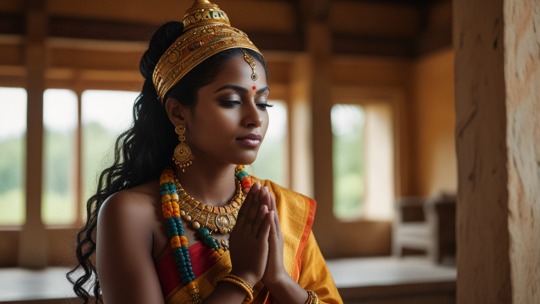
In Vedic astrology, the placement of Ketu in the 1st house of a natal chart holds profound significance. This positioning shapes a person’s identity, personality, and spiritual journey in unique ways, creating a blend of mystical influences that touch all areas of life. Known as a "shadow planet," Ketu is associated with detachment, spirituality, and karmic lessons, often influencing how an individual views themselves and interacts with the world. When positioned in the 1st house—the house representing the self, appearance, and how one projects themselves—Ketu's influence can be intense, bringing both challenges and profound insights.
Self-Identity and Personality: The Karmic Veil of Ketu
The presence of Ketu in the 1st house often introduces complexities in self-identity. Individuals may experience an unusual detachment from their personal identity, finding it challenging to define themselves or their role in society. This detachment can manifest as feelings of alienation or an unshakable sense that they are somehow "different" from others. Often, those with this placement project an unconventional personality, as Ketu encourages them to break from societal norms and seek their truth.
This placement promotes a deep inner journey toward self-discovery. The individual’s ego and self-perception are continuously tested, compelling them to question their true identity. As a result, individuals with Ketu in the 1st house may feel a strong desire to explore life's mysteries, searching for answers that resonate with their soul rather than with external expectations.
Spirituality and the Quest for Higher Knowledge
One of the most distinctive effects of Ketu in the 1st house is the heightened inclination towards spirituality and metaphysical subjects. People with this placement are drawn to spiritual practices, meditation, and philosophy, often in pursuit of higher knowledge. Ketu's energy drives them to seek answers beyond the material realm, prompting a quest for enlightenment and deep inner peace.
This placement encourages a person to reflect on life’s transitory nature, understanding that physical and material experiences are fleeting. Such individuals often prioritize inner growth and spiritual fulfillment over worldly success or validation. They may also feel a deep connection to ancient wisdom and esoteric teachings, preferring to spend time in introspective pursuits rather than conventional social engagements.
Physical Health and Mind-Body Connection
The influence of Ketu on physical health is subtle yet impactful. Often, Ketu’s placement in the 1st house brings challenges related to physical well-being, particularly in areas tied to the digestive system and mental health. This may manifest as gastrointestinal issues or conditions such as anxiety and depression. The root of these health issues often lies in Ketu’s tendency to disconnect individuals from their bodies, leading to neglect of physical needs.
It is crucial for those with Ketu in this position to foster a mindful approach to health, grounding themselves to counter Ketu's ethereal nature. Engaging in mind-body practices like yoga or tai chi, along with a balanced diet, can help restore the necessary connection between body and mind. Mindfulness practices can provide grounding, ensuring that the individual remains aware of their physical state amidst their inclination toward spiritual detachment.
Relationships and Emotional Detachment
Ketu in the 1st house affects how individuals approach relationships and interpersonal dynamics. Often, there is a sense of detachment or non-attachment in personal connections, which can make it challenging to forge deep emotional bonds. These individuals may seem aloof or emotionally distant, as Ketu’s influence encourages them to withdraw from emotional entanglements, leading to misunderstandings in relationships.
However, this emotional detachment is not necessarily negative. For many, it allows a more objective and rational approach to relationships, enabling them to focus on meaningful connections rather than superficial attachments. They may form relationships that align with their spiritual values or attract partners who share their pursuit of higher wisdom. For relationships to thrive, it’s essential for these individuals to find people who respect their need for space and introspection.
Life Purpose and Direction: A Journey of Self-Discovery
Ketu in the 1st house influences an individual’s sense of purpose, often driving them away from traditional paths and toward a unique, personal journey. These individuals tend to question societal expectations and may reject conventional definitions of success, preferring instead to pursue what feels authentically fulfilling. Ketu’s influence leads them to seek a higher calling, a path that resonates with their inner values rather than external achievements.
This placement encourages introspection and self-awareness, prompting individuals to explore life’s deeper meaning. It often leads to a feeling of wandering or constant searching, as they move through various experiences and challenges that shape their identity. Ketu’s guidance helps them discover that true fulfillment comes not from external validation but from spiritual growth and self-discovery.
Personal Transformation and Growth: Lessons of Ketu
Ketu in the 1st house brings about significant personal transformations over time. The journey with Ketu is often tumultuous, with each experience acting as a lesson that pushes the individual towards growth. The transformative periods they undergo are not just random events but are often karmic in nature, guiding them toward self-realization. They may find themselves letting go of old identities and attachments, constantly reshaping who they are in search of a deeper truth.
These transformations, though sometimes painful, are ultimately beneficial. They serve as catalysts for growth, helping the individual shed the superficial layers of identity and dive deeper into their spiritual essence. The lessons learned during these transformations lead to an enlightened understanding of the self and the world around them.
Karmic Lessons and Past-Life Connections
Ketu is often seen as a karmic planet, and its placement in the 1st house suggests that there are karmic lessons tied to the individual’s self-identity and expression. The challenges they face may stem from past-life issues or unresolved conflicts related to the ego. This placement often brings situations that force individuals to confront parts of themselves that they may have ignored or denied.
These karmic lessons are not meant to punish but to guide the individual toward spiritual maturity. By facing and overcoming these challenges, they gain wisdom and insights that help them grow. Ketu in the 1st house acts as a reminder of the transitory nature of identity, encouraging them to embrace their true self without attachment to superficial labels or roles.
Conclusion
The placement of Ketu in the 1st house offers a unique mix of challenges and opportunities. While it may bring issues related to health, relationships, and self-identity, it also fosters profound spiritual insights and a path toward enlightenment. Individuals with Ketu in this position are often on a journey of self-discovery, exploring their true nature and seeking a deeper understanding of life’s mysteries. By embracing the lessons of Ketu, they can transform their lives in powerful ways, ultimately finding peace and fulfillment through spiritual growth.
The impact of Ketu in the 1st house is deeply personal and varies based on the individual’s entire natal chart, including aspects, conjunctions, and other planetary influences. Seeking guidance from an experienced astrologer can provide further clarity and support in navigating these complex influences.
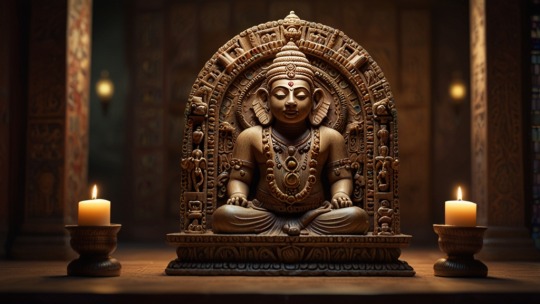
#zodic signs#astrogurujimayank#astrology#astrology blog#horoscopes#zodiac#12th house#astro tumblr#jyotish#sidereal astrology
9 notes
·
View notes
Text
Embrace the Harmony Within Yoga- The Soulful Dance of Cells, in Perfect Rhythm with the Breath. In this fast-paced world, finding serenity amidst the chaos is a precious gift. Yoga, the ancient art of mindfulness, offer this precious opportunity.
Check our Yoga Retreat!
Welcome to our yoga retreat! We are thrilled to have you join us on this transformative journey of self-discovery, relaxation, and rejuvenation. Our retreat is designed to provide you with a nourishing and holistic experience, allowing you to reconnect with your mind, body, and spirit in a serene and supportive environment.
Throughout your time with us, you will have the opportunity to deepen your yoga practice, explore various meditation techniques, and cultivate mindfulness. Our experienced and passionate instructors will guide you through yoga sessions tailored to your needs and level of experience, helping you develop strength, flexibility, and inner awareness.
In addition to the yoga and meditation practices, we have curated a schedule that includes workshops and lectures on topics such as yoga philosophy, anatomy, nutrition, art and holistic wellness. These educational sessions aim to enhance your understanding of the yogic lifestyle and provide you with valuable tools for personal growth and well-being.
Our retreat takes place in a beautiful natural setting, surrounded by the tranquil beauty of nature. You will have the chance to immerse yourself in outdoor activities, such as hiking, nature walks, or simply taking in the peaceful atmosphere. This connection with nature will enhance your overall experience and promote a sense of harmony and tranquility.
At our yoga retreat, you will also have the opportunity to connect with a community of like-minded individuals who share your passion for yoga and holistic living. The bonds and friendships formed during this retreat often become cherished and supportive connections that extend beyond our time together.
We are excited to embark on this transformative journey with you and create a space where you can nurture your body, mind, and spirit. Get ready to experience the healing power of yoga, embrace self-care, and rediscover your inner balance. Welcome to our yoga retreat!
#yogastudent#meditation#yogaretreat#yogateachertraining#yogatraining#love#yoga#healthylifestyle#vinyasa#nature#yoga retreat#india#health & fitness#health#wellness#wellbeing#nutrition#beach#goa#spiritual practitioner#practice
68 notes
·
View notes
Text
A Short Introduction to the Yoga Sutras
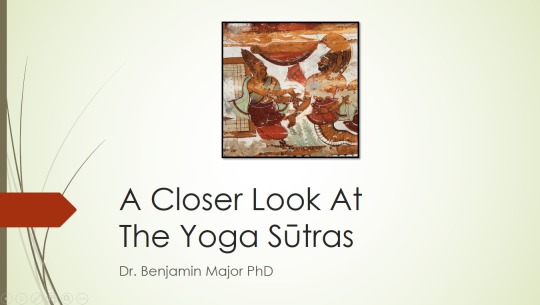
The Yoga Sutras are generally considered a foundational text of the yoga tradition. In this article we examine the context and background of the text, briefly explore its structure and content, and I also offer some reflections on the text’s relevance in modern times.
Note: I have decided not to use diacritics in this article. Diacritics are those little lines and dots above and below letters that tell you how to pronounce Sanskrit words. Normally I use diacritics in my writing, as they are essential for pronouncing Sanskrit correctly. However as this article is meant for non-scholars I have decided it would be better to try and write the Sanskrit words in a way that will make them easy to read and pronounce, so as not to put anybody off!
History & Context
Most scholars these days date the Yoga Sutras to somewhere between the 2nd and 5th centuries CE, with Philipp Maas placing it in the early 5th century.
The text is attributed to a sage named Patanjali. Biographically, we know next to nothing about Patanjali. The name is a compound word formed from the Sanskrit words pata (falling, flying) and anjali (the gesture of joining the hands together in reverence).
Yoga had already been around in some form or another for many centuries by this point. Therefore, Patanjali did not ‘invent’ Yoga. Nevertheless, this is the earliest comprehensive and systematic text on the subject that has survived.
Yoga was just one darshana or school out of many in ancient India. In terms of philosophy, it shares many similarities with the Samkhya school. But whereas Samkhya tends to emphasise the use of reason and knowledge to gain liberation, Yoga emphasises practical and experiential methods.
Philosophically, both the Samkhya and Yoga schools teach a form of dualism. This is a dualism between purusha (our true Self) and prakriti (everything else, including the body and mind) and the whole point of Samkhya and Yoga in a nutshell is to guide us towards the realisation of purusha, that is, our true Self. This is true liberation or moksha in Yoga.
Most of the ancient darshanas had their own sutra text. Sutra texts are known for their brevity. Basically, sutra texts are where the most essential teachings of a school are distilled into as few words as possible. Knowledge systems were handed down orally in ancient India and thus source material was kept minimal with a view to facilitating memorisation.
Other authors would then come along and write longer commentaries on these sutra texts. The Yoga Sutras have a rich commentarial tradition spanning many centuries. The first and most well known is the bhasya commentary by a certain Vyasa. Vyasa actually means something like ‘compiler’ or ‘editor’ so that probably wasn’t his actual name!
Some scholars even argue that Patanjali and Vyasa are actually one and the same person, though others would strongly disagree with this thesis. Either way, this commentary is indispensable when it comes to making sense of the sutras, and published versions of the Yoga Sutras tend to include the bhasya commentary or at least reference it.
As a final note, many scholars now use the term pātañjalayogaśāstra to refer to this text as a whole (sutras plus commentary), because that is the name our oldest existing manuscripts use. But to keep things simple we will continue to use the name Yoga Sutras!
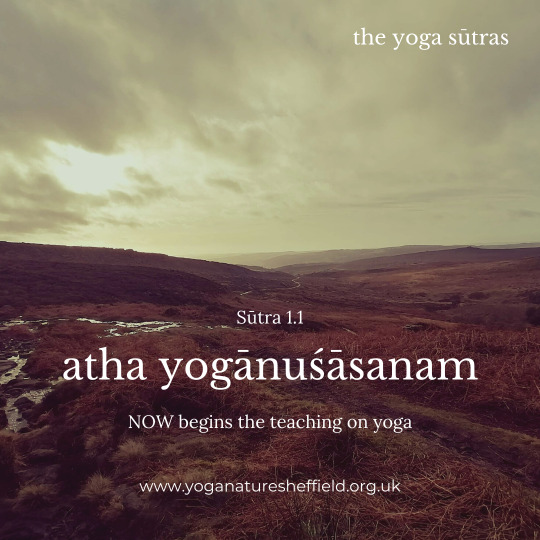
Structure of the Text
The Yoga Sutras are divided into the following four padas or chapters:
Samadhi Pada: This is where Patanjali defines Yoga and then describes the nature and the means to samadhi, the goal of Yoga.
Sadhana Pada: Sadhana is the Sanskrit word for practice or discipline. Here the author outlines two forms of Yoga, the kriya yoga (yoga of action) and the ashtanga yoga (the yoga of eight auxiliaries or limbs). This is also where Patanjali discusses the kleshas, five ‘afflictions’ or impediments to Yoga.
Vibhuti Pada: Vibhuti is the Sanskrit word for power or manifestation. Supra-normal powers (siddhis) are said to be acquired by the practice of Yoga. However, the temptation of these powers should be avoided and the attention should ultimately be fixed only on liberation.
Kaivalya Pada: Kaivalya literally means isolation. This is the chapter on final liberation. The Kaivalya Pada describes the process of liberation, it explains how the mind is constructed and veils the inner light of the Self.
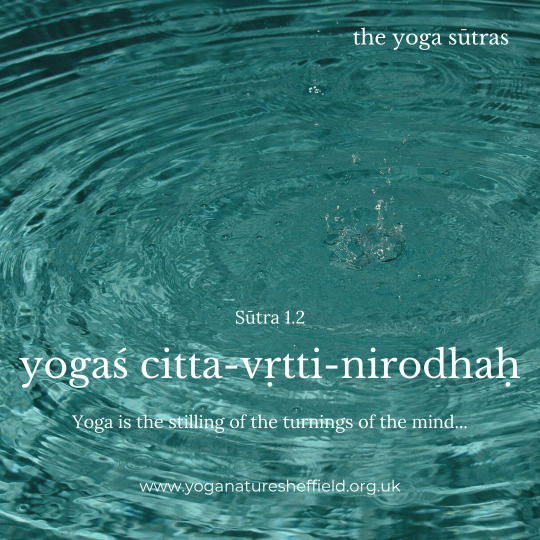
The Goal of Yoga
Not one for a lengthy preamble, Patanjali gets stuck right in there and clearly states the goal of Yoga in the well-known second sutra:
yogas chitta-vritti-nirodhah YS 1.2
Any Sanskrit sentence allows for a number of possible translations and this one is no different. A nice and accurate one is this one from Barbara Stoler Miller:
Yoga is the cessation of the turnings of thought
The reason I say this one is accurate is because a literal meaning of vritti is ‘turning’. Ever felt that thoughts are ‘going round and round’ in your head? Well this phrase nicely captures that! The vrittis in this statement refer to thoughts, emotions, ideas and basically any cognitive act of the mind. Patanjali lists five types of vrittis. These are, once translated:
Right knowledge
Error or false knowledge
Imagination
Sleep &
Memory
All such activities of the mind are products of prakriti and are completely distinct from the true Self, purusha, that pure awareness or consciousness which we are aiming to enter into through Yoga. The means prescribed by Patanjali in the first chapter of the Yoga Sutras to still the vritti states of mind are sustained practice (abhyasa) and dispassion (vairagya).
Specifically the practice offered is meditation, or keeping the mind fixed on any particular object of choice without distraction. Patanjali then describes a number of possible forms such meditation could take. By stilling all thought, meditation removes all objects of awareness. Awareness can therefore now be aware only of itself, of its own source, the true Self or purusha. This state is known as samadhi in Yoga and Patanjali makes it super clear that this state of samadhi is the goal of Yoga and thus the whole text is focused upon achievement of that goal.
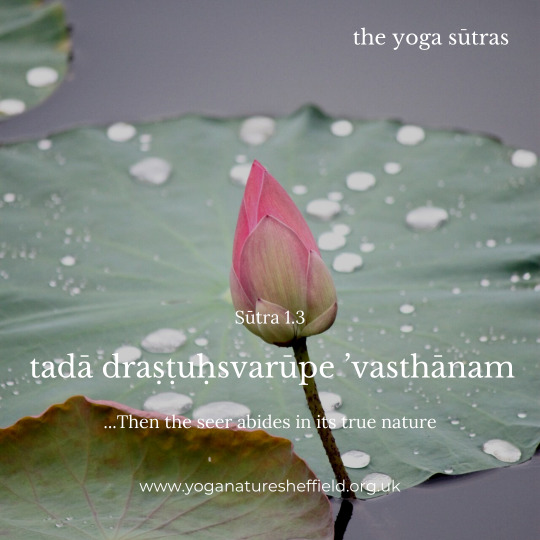
Obstacles to Yoga
Patanjali mentions five kleshas, which can be translated as impediments or obstacles to achieving samadhi and thus Yoga. These five are as follows:
Ignorance
Ego
Desire
Aversion
Clinging
In the Yoga Sutras, and indeed in ancient Indian philosophy in general, the first item in any list is the most important and fundamental. It’s the same here. Ignorance here means failing to recognise our true Self or purusha and instead identifying ourselves with our body, mind and the material world. All of the other obstacles arise from this fundamental error.
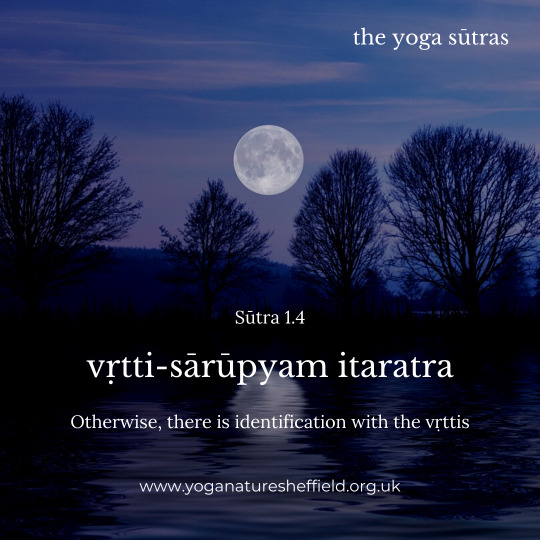
Yoga Psychology
Like most other schools of Indian thought, the Yoga school believed in the related concepts of karma and rebirth. According to this doctrine, we are caught in an endless cycle of rebirths called samsara and the purpose of following a path such as Jainism, Buddhism or Yoga is to bring an end to this cycle. Where the Yoga Sutras really shine are in interpreting this doctrine in a highly sophisticated ‘psychological’ way, to use modern terminology.
According to this Yoga psychology, the mind forms an impression of an object through the sense organs, which is called a pratyaya. Once this pratyaya or active image of this object is no longer of active interest to the mind, it becomes an inactive or latent samskara. A samskara is an imprint left in the chitta, somewhat like a sound is imprinted on a tape recorder, or an image on photographic film. In this way the vrittis, the activities of the mind, are retained as samskaras when they fade.
It is important to note that these samskaras are not just passive imprints but vibrant latent impulses that can get activated under conducive circumstances and can exert influence on a person’s thoughts and behaviours, even many years after the impression was made. What’s more, according to Yoga these samskaras can persist from previous lives. The chitta is thus something of a storehouse of these recorded samskaras, deposited and accumulated there over countless lifetimes. One is here reminded of the theory of the subconscious in modern psychoanalysis.
According to Yoga, karma is generated by the vrittis, and the vrittis, in turn, are produced by the kleshas. There is thus a vicious cycle of kleshas, vrittis and samskaras. To run through the whole cycle again to try and make it as clear as possible: vrittis are recorded in the chitta as samskaras, and these samskaras eventually activate consciously or subliminally, producing further vrittis. These vrittis then provoke actions and reactions, which in turn are recorded as samskaras, and the cycle continues endlessly, leading to much suffering along the way.
The whole Yoga project aims to bring this vicious cycle to an end and it is liberation from this mind created suffering that we are after as yogis. The Yoga Sutras are effectively a manual guiding us towards this end, this state of samadhi or complete meditative consciousness.
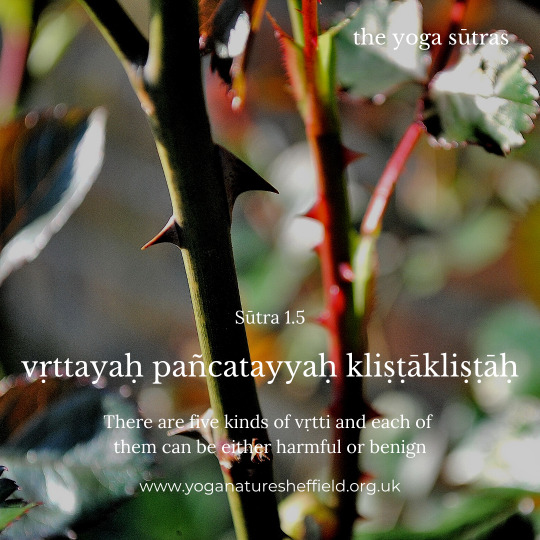
The Yamas and Niyamas
The second pada or chapter of the Yoga Sutras contains a famous exposition of five ethical restraints (yamas) and five ethical observances (niyamas) and these are relatively well-known in the modern yoga world. The first thing to get clear is that these yamas and niyamas are NOT original or unique to Yoga. All ascetic schools in ancient India had these ethical codes, and the exact same ones appear in Jainism for example. Sometimes, you even get more of them. Some yoga texts for instance list 10 yamas and 10 niyamas.
The five yamas listed in the Yoga Sutras are:
Ahimsa (non-harming) Satya (truth telling) Asteya (non-stealing) Brahmacharya (chastity or celibacy) Aparigraha (non-acquisitiveness)
The five niyamas are:
Shauca (purity or cleanliness) Santosha (contentment) Tapas (self-discipline) Svadhyaya (study) Ishvarapranidhana (devotion to the Ishvara or Lord)
Many of these could do with further explanation and commentary but there is not space in this present article. The other thing I want to stress is that these yamas and niyamas were not seen as optional extras for yogis. Rather, these were the bedrock of fruitful yoga practice. Patanjali and others refer to them as the mahavratam or ‘great vow’. Importantly, having listed the yamas, Patanjali devotes an entire sutra to reiterating just how central and non-negotiable these yamas are. Once translated, this sutra reads as follows:
[These yamas] are considered the great vow. They are not exempted by one’s class, place, time or circumstance. They are universal. YS 2.31
So, regardless of your social status, regardless of where you live, in which time period you live, and any other extenuating circumstances (such as your career), adherence to the yamas, including especially ahimsa, the foundation of them all, is an essential part of being a yogi as defined by Patanjali’s system.
Vyasa is even more emphatic in his bhasya commentary to the Yoga Sutras, and it is here that the link between ahimsa and vegetarianism is explicitly and unequivocally made, and several examples are brought to bear. Refer to the work of scholar Jonathan Dickstein to read more about the strong case for vegetarianism made in Patanjali Yoga.

The Ashtanga Yoga
These yamas and niyamas are just the first two parts of Patanjali’s famous ashtanga or eight-part path. I would first like to clarify that this systematisation of yoga into a series of angas (a word translated by some modern scholars as ‘auxiliaries’ but more commonly rendered as ‘limbs’) was again not novel to Patanjali. Throughout the yoga tradition we find various similar schemes, predating and postdating Patanjali, including fourfold, fivefold, sevenfold and even fifteenfold schemes. I would also like to stress that, despite sharing the same name, this ashtanga yoga bears little relation to the modern postural form of yoga known as Ashtanga.
Following the yamas and niyamas then, we then have the following six angas:
Asana (posture): At last I hear you cry, postures! In Patanjali’s day meaning a steady and comfortable seated posture, asanas today comprise a set of physical exercises which stretch and strengthen the body. It is this aspect of yoga that has been most visibly exported to the West but too often stripped from its context as just one ingredient in a more ambitious and far-reaching sequence.
Pranayama (breath control): Prana refers to the universal life force whilst ayama means to regulate or control, but it can also mean to expand and lengthen. Prana is the vital energy needed by our physical and subtle layers, without which the body would perish. It is what keeps us alive. Pranayama is thus the control or expansion of prana through the breath, depending on which definition of ayama you use.
Pratyahara (withdrawal of the senses): This limb further deepens the above process by removing consciousness from all engagement with the senses (sight, sound, taste, smell and touch) and sense objects.
This is followed by the final three limbs collectively known as samyama: Dharana (concentration, fixation), Dhyana (meditation), and finally Samadhi (the latter of which Patanjali further divides into seven rather esoteric stages). These last three limbs are essentially different degrees of concentrative intensity and culminate in the realisation by the Self of its own nature.
Just to reiterate one more time, it is this Self-realisation, the state known as samadhi, that is the true goal of Yoga.
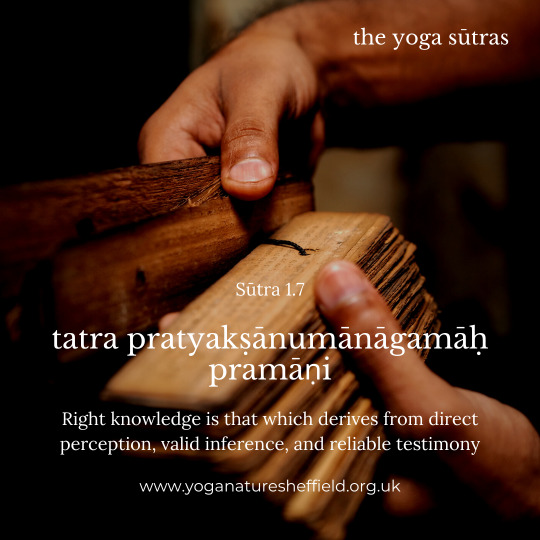
Relevance of the Yoga Sutras for Today
In this brief introduction we have of course only scratched the surface of this incredible text, and there is much more that could be said. But for now I want to end with some concluding reflections on the continuing relevance of the Yoga Sutras in the modern world.
One question that arises is whether Patanjali was prescribing a strictly ascetic path. And indeed, the general scholarly consensus has usually been to associate Patanjali's Yoga exclusively with extreme asceticism, mortification, denial and renunciation. However, there are dissenting vocies. For example, Ian Whicher has repeatedly and passionately argued that Patanjali's Yoga can be seen as enabling a more responsible living in and engagement with the world, and that Patanjali was not advocating total renunciation. For Whicher, following the path of Patanjali can lead one towards that integrated and embodied state of liberated selfhood whilst living, a state known as jivanmukti.
Regardless of whether Patanjali was historically preaching ascetism or not, the fact remains that the Yoga Sutras are full of valuable ideals and tools for the practitioner living in the modern world. Let’s face it though, this is a challenging path. As a scholar and practitioner I often perceive a huge disconnect between the kind of yoga I am seeing on the likes of Instagram and the teachings of the Yoga school as presented in the Yoga Sutras. After, all, the former is highly focused on body image, whereas the Yoga of Patanjali is all about dissociating ourselves from our body and mind and recognising our true Self. However, this does not mean that the two are necessarily irreconcilable.
Though there is absolutely no historical evidence that Patanjali and his followers were practicing postural yoga (that didn’t come until later with the emergence of the Hatha tradition) nowhere in the Yoga Sutras does it say that physical exercise cannot be part of one’s yoga practice. We just have to remember that as far as Patanjalian Yoga is concerned, such postural activity is just a further means or method on the path towards samadhi or full meditative awareness. This is why any so-called yoga that does not contain more internalised meditational practices but which focuses solely on physical exercise should not really be called yoga.
The Yoga Sutras remains undoubtedly the most famous ancient yoga text, and it is studied to some extent in probably every yoga teacher training course. To be honest, I personally feel that too much emphasis is placed on the Yoga Sutras, at the expense of other branches and other texts of the tradition. The Tantric texts, in particular, are still sorely neglected. One of my own aims in my work is to try and decentre the Yoga Sutras and provide a much wider overview of the history and philosophy of yoga and the other related schools of ancient India. This is not to take anything away from the Yoga Sutras, however, as it is without doubt an extraordinary text that continues to be highly relevant in the 21st century.
Further Reading
I have already mentioned some scholars whose work you may wish to refer to, such as Philipp André Maas, Ian Whicher and Barbara Stoler Miller. For a translation and commentary on the Yoga Sutras that is both scholarly accurate and reasonably accessible I would recommend that of Edwin Bryant published by North Point Press.
11 notes
·
View notes